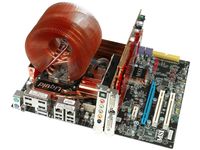How To: Get A 4 GHz Dual-Core For $120
Conclusion
Many processors suitable for overclocking present disadvantages: they’re either too expensive (think of Intel’s Extreme series) or they don’t deliver sufficient performance (Pentium Dual Core family). However, we found an overclocker that provides a great mix of performance and cost: the Core 2 Duo E7200, which is available for less than $120. It delivers mainstream performance at stock speeds, but provides better computing power than the fastest dual cores available.
Overclocking Is Easy
Overclocking this processor is easy, as most motherboards support running such a CPU at faster bus speeds. Operating the Core 2 Duo E7200 at FSB1333 rather than FSB1066 results in core clock speed of 3.16 GHz instead of 2.53 GHz. Switching to FSB1600 results in a 3.8 GHz core clock speed, an increase of about 50 percent. We found this extremely easy to achieve on an MSI P45 Diamond high-end motherboard. We increased the processor voltage in the motherboard BIOS to 1.4 V, switched the chipset to a slightly higher voltage, and achieved a perfectly stable system that outperforms all other Core 2 Duos—even those with 6 MB L2 cache.
E7200 Performance & Power
The overclocked Core 2 Duo E7200 at 3.8 GHz performs way better than the E8500 at stock speed. The only applications in which the overclocking of the E7200 was less effective were some games and WinZip, which is very sensitive regarding L2 cache capacity and memory performance. For all other benchmarks the E7200 at 3.8 GHz provided amazing performance. Using a high-performance Cooler Master 850 W power supply, peak power increased 40 percent and idle power increased roughly 10 percent. Using a model with less output (roughly 400 W to 500 W), however, would decrease power requirements by several watts. It’s wise to purchase an efficient processor cooler, as the stock device isn’t able to keep up with heat dissipation at 3.8 GHz; we used a Zalman CNPS-9700 LED.
Outlook
Overclocking to 3.8 GHz isn’t the maximum for the Core 2 Duo E7200—we’ve read forum posts from users running this processor at 4 GHz. In some cases, especially if you don’t alter the processor voltage, you may be limited to 3.5 or 3.6 GHz. We believe this processor offers the best overclocking bang for the buck. More E7000 models will likely follow, which means there will be processors that support higher multipliers, so you’ll be able to overclock with a smaller bus speed increase.
Get Tom's Hardware's best news and in-depth reviews, straight to your inbox.
